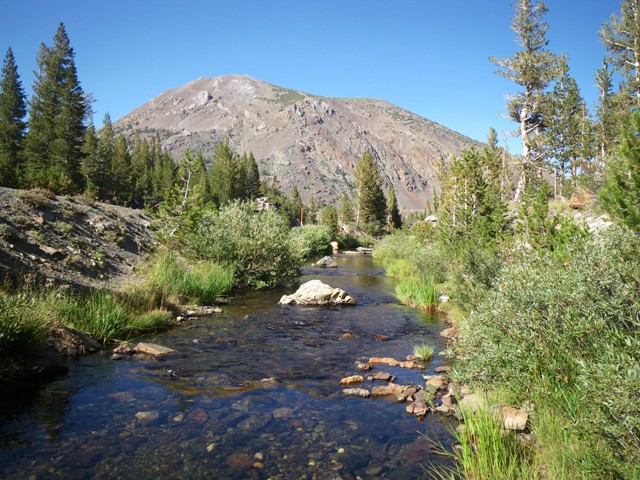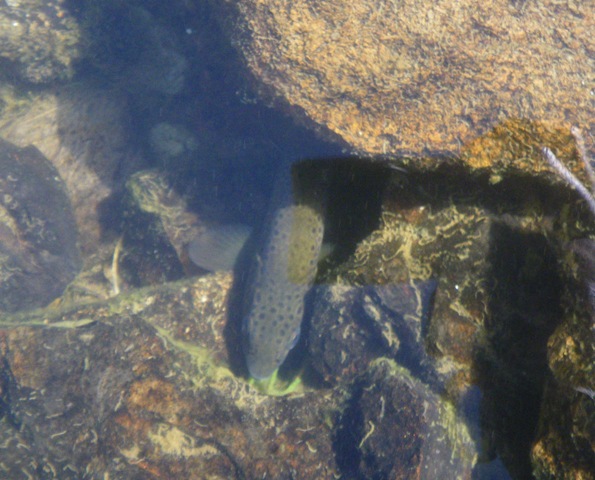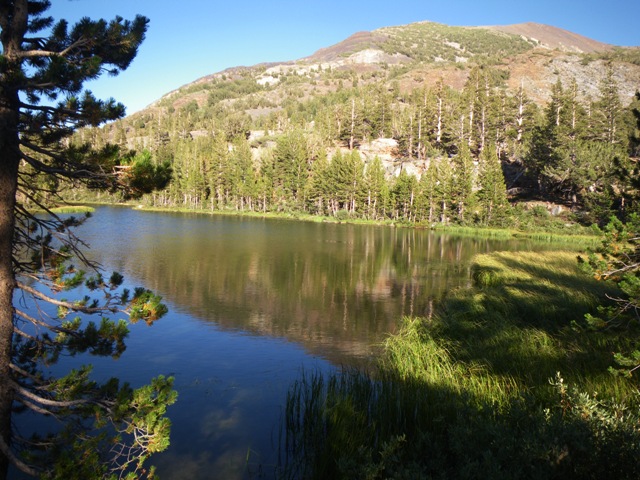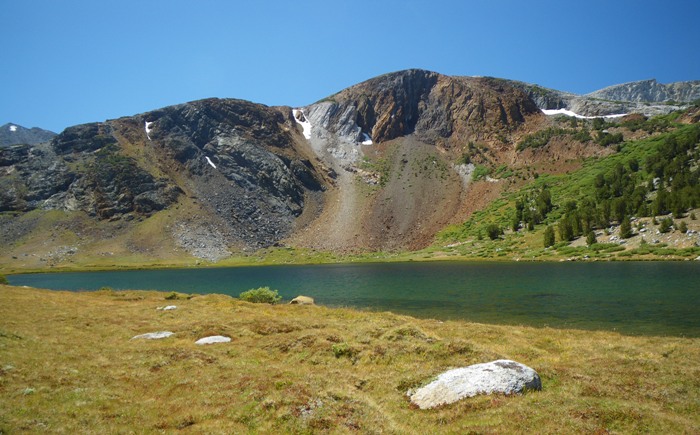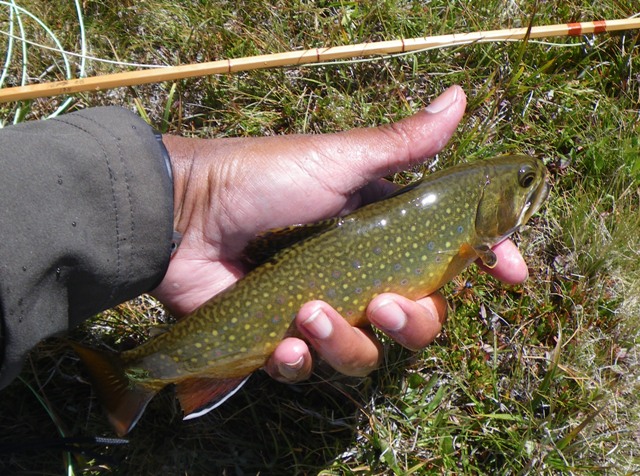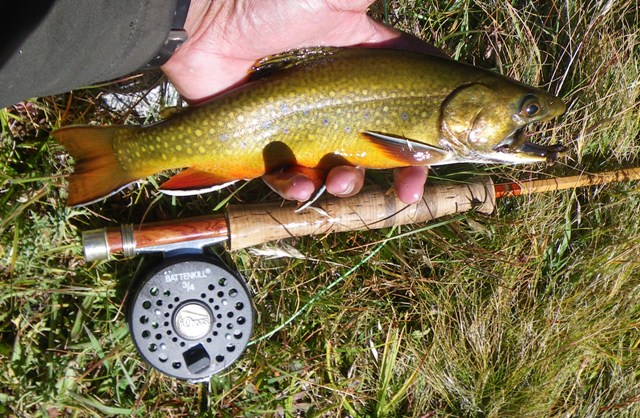|
|
|
|
|
August 26th- 27th 2009- Tioga Pass area, Yosemite National Park Time: Wednesday 3:00pm - 7:00pm,
Thursday Noon to 5:00pm The cool, thin mountain air burned my nostrils as I hiked the wooded trail through Yosemiteís silver mine country on Thursday. My destination was not only new, it was unknown. A few days earlier I had laid my map out looking for trails to hike and lakes to fish in northern Yosemite. There are so many lakes and streams in Yosemite that I have yet to visit. I picked a few at random and then checked the trail profiles on my Topo software. Several fit the bill nicely and so I left my house on Wednesday morning with a general plan- a short hike to the Lyell Fork of the Tuolumne River that afternoon and a longer hike to a new lake the following morning after acclimatizing to the 10,000 feet altitude.
A
simple glance at a map will show that there are many running waters in the
area and that the Dana and Lyell forks of the Tuolumne are not the end all
and be all of the fly fishing in Tuolumne Meadows. I decided to fish a
stream "hidden in plain sight".
I
wasn't fishing, at least not yet. I was simply enjoying the icy cold water
flowing through my crocs and laying out cast after cast in mesmerizing
rhythm. Iíd been fishing my 3 wt and finally found something that it didnít do well- casting into the wind. The rod wasnít really designed for casting into the wind but every high country rod will need to do so sooner or later. Itís deficiencies in the wind were far out weighed by itís superiority as a roll casting tool, another pleasant surprise.
That evening I set out to test the rod on the large fish of Hot Creek. I spent about 45 minutes at Hot Creek and was unable to turn up anything larger than a 13 inch Brown Trout. The heavy trout test will have to wait. Thursday morning I was back in Yosemite, a quick breakfast at the Saddlebag Resort and I was off to a popular trailhead. The cool, thin mountain air burned my nostrils as I hiked the wooded trail through Yosemiteís silver mine country. I barely noticed the resulting headache as I was enthralled by the small stream that parallels the trail all the way to the lake. Iíd fished a portion of this stream before but had never seen this section and certainly never followed it to it source. That source was my destination and as tempting as the stream was, it would have to wait. I followed the trail to its terminus at the lake. When I first approached, the egg plant shaped lake was somewhat obscured and I was unsure if I was actually at the lake. At first glance it looked like little more than a flooded meadow with a few deep holes; as I crested the small rise where the trail ends, I could see that the outlet was at the narrow portion of the lake. The wide portion of the lake was surrounded on two sides by a steep ridge and the closer I approached, the more it became obvious that this wide portion was farther and larger than it looked. If would take me over 2 hours to fish the lake's circumference.
I sat on a small rock barely higher than the yellow grass of the basin plateau eating lunch and looking for active fish. A fish rose directly in front of me about 20 feet from shore. Another rose in the middle of the lake. When I finished eating I walked slowly toward the bank peering through the surface of the blue green water at the shapes below. Eyes focused in such a way that any movement could be quickly detected and assessed. No cruising fishing. I crawled the final few feet to the waterís edge. The bank was elevated, about 18 inches above the water. The water had that eerie clarity that usually means that the lake is twice as deep as it looks. No wading for me today. A weed bed lined much of the lake about 10 to 15 feet from the bank. The water was clear but the dark green mass was too deep to see in detail. Beyond, the various shades of blue hinted at the lake depth and fish were impossible to spot unless they were cruising along the sandy bottom close to shore. I cast my black ant to the center of the weed bed. The weed bed was long but not very wide. I made several casts at various points. I cast to where the green weeds met golden sand near shore. I cast in the center of the weeds, well past the point where dark green was distinguishable from black. I cast to the edge of where black was replaced by an abyss of turquoise blue. Nothing. I then repeated this pattern in reverse, this time giving my line a slight pull just after the fly hit the water. Thatís all it took; I was quickly into my first Brook Trout of the day. It was nice sized fish as high country brook trout go, a healthy 10 inches and well feed. The slight skittering of my ant worked well but I started to wonder if the lake might hold more than 7 to 10 inch brook trout. Iíd noticed an insect shuck while landing one of the fish. Iím somewhat hesitant to say it but it looked like a giant midge shuck. It was about a size 10, the kind of midges you read about in Britain or Canada, not at 10,000 feet in the Sierra. I may have to tie some large midges for the next time but this time around I simply tied on a Stillwater nymph in hopes of catching some large fish.
The Stillwater nymph was a hit and I quickly picked up fish but they werenít really any larger than what I was catching with the dry. I moved a little closer to the inlet to an area where the weeds were a little closer to shore and a dark diagonal line seemed to signify a drop off. More weeds or drop off it was hard to tell but what was pretty obvious is that the old stream bed sat below this portion of the lake. There was an obvious current here but when the wind blew, a wide line down the center of the lake could be seen. On my second cast to the far side of this invisible channel I hooked and landed an 8 inch brown. The only brown trout I can recall catching in a high country lake. I continued to use the Stillwater Nymph but casting with different retrieves only resulted in one more fish from this area- a large brown that was promptly lost. Typically I get chased out of the high country by afternoon storms but this afternoon the sky was a pale blue with nary a cloud in the sky. I decided to work my way around the lake in search of larger fish. I worked my way up the shoreline to the main inlet. The water was barely flowing and the lake in this area was very shallow. This end of the lake buttressed up against a north facing ridge and was extremely marshy, either from hidden springs or late season snow melt. On the far shore, headed back toward the outlet I came across water almost identical to what I had been fishing earlier but still wasnít catching fish. When I started to see fish but wasnít catching, I lost confidence in the Stillwater Nymph and tied the Black Ant back on. The ant was drawing strikes but I could see that there were a few larger fish that seemed to be ignoring it. (I may have been placing the fly too close to these fish; they didn't flee but they stayed uncharacteristically still as the fly bobbed overhead.) I decided to switch to a caddis cripple and for the next hour, until I left the lake, the fishing was excellent. Not excellent because the cripple was readily catching fish; it was, but what made the next 60 min. excellent was that it was catching sighted fish. On the opposite shore, the wind was down, the light was good and I started seeing fish more easily, even over the dark backdrop of the weeds.
It was late and I was fishing fairly quickly. I was walking the shoreline and would only stop and fish if I saw a disturbance, fish or something else caught my eye. I came to a rock on a slight point and decided to stop. I donít recall if the fish was simply cruising or had just sipped something from the surface but I saw it and made a cast that landed about 4 feet in front of the fish. Far enough that it wouldn't spook him and close enough that the trout had to register the disturbance on the water. The fish disappeared and I waited and waited, trying to guess how long it would take for the brookie to swim to the fly and wondering if it had already swam past as was simply not interested. The wait was hardly bearable. Most of the fish I had spotted and cast to, rushed the fly with abandon but that was the ant, this was the cripple and I guess the fish figured the cripple wasnít going anyway. Suddenly a nose appeared and I had hooked my largest Brook Trout of the day. The bank here was higher than elsewhere and laying on my side, my arm was just long enough to reach and release the fish. The next fish was about the same size. I had walked a couple of yards along the bank, spooking a few trout that were using the bank for cover, when I spotted a large brook trout headed in my direction. The fish was very shallow, just inches below the surface and my first cast landed 6 inches behind it's head. I expected the fish to turn around and slam the fly and when that didnít happen I made another cast. The brookie turned toward me suddenly and the fly landed to its left- again, no interest. I was convinced the fish hadnít seen the fly so borrowing from my approach earlier in the day, I slowly dragged the fly toward the fish. A cheeky move to be sure but the fish turned and engulfed the fly without hesitation. I released the fish and mentally called it a day. I continued to survey the remaining portion of the lake but did little casting. I was headed back to the trailhead by 5:15pm and home by 11:00pm.
Previous Yosemite / Ansel Adams Wilderness Chronicle Next Yosemite / Ansel Adams Wilderness Chronicle
|

